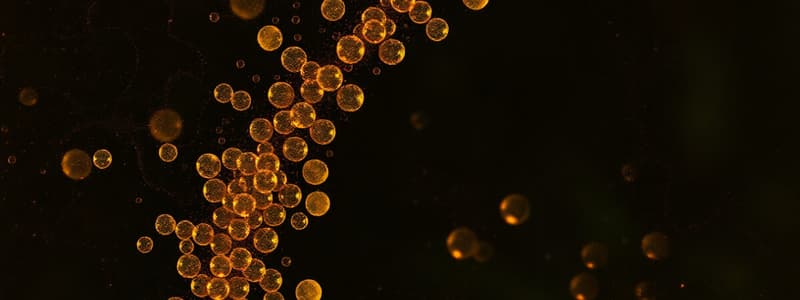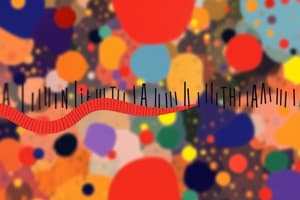Podcast
Questions and Answers
What role do chromatin remodeling complexes play in gene expression?
What role do chromatin remodeling complexes play in gene expression?
- They regulate chromatin structure. (correct)
- They modify the DNA sequence.
- They enhance protein synthesis.
- They directly synthesize RNA.
Which process is NOT a mechanism of gene expression regulation?
Which process is NOT a mechanism of gene expression regulation?
- DNA methylation
- Histone modification
- Chromatin remodeling
- RNA splicing (correct)
What is the concept of a 'master regulator' in gene expression?
What is the concept of a 'master regulator' in gene expression?
- A protein that regulates the expression of multiple genes. (correct)
- A mutation that disrupts normal gene function.
- An enzyme that synthesizes RNA from DNA.
- A gene that operates independently of others.
How does DNA methylation contribute to cellular memory?
How does DNA methylation contribute to cellular memory?
Which of the following best describes transcriptional regulators?
Which of the following best describes transcriptional regulators?
Which mechanism does NOT influence chromatin structure?
Which mechanism does NOT influence chromatin structure?
What is the primary function of enhancers in gene regulation?
What is the primary function of enhancers in gene regulation?
Which factor is NOT essential for the action of transcriptional regulators?
Which factor is NOT essential for the action of transcriptional regulators?
What role do activators play in transcription regulation?
What role do activators play in transcription regulation?
How does DNA methylation affect gene expression?
How does DNA methylation affect gene expression?
Which enzyme is responsible for adding histone modifications?
Which enzyme is responsible for adding histone modifications?
What effect does tight packing of chromatin have on transcription?
What effect does tight packing of chromatin have on transcription?
What is the consequence of unmethylated CpG islands in mammalian genes?
What is the consequence of unmethylated CpG islands in mammalian genes?
How can combinations of transcriptional regulators affect cell type development?
How can combinations of transcriptional regulators affect cell type development?
What is the function of chromatin remodeling complexes in gene regulation?
What is the function of chromatin remodeling complexes in gene regulation?
What outcome is associated with methylated CpG islands?
What outcome is associated with methylated CpG islands?
How do positive feedback loops contribute to cell memory?
How do positive feedback loops contribute to cell memory?
What is the role of histone modifying enzymes in cell memory?
What is the role of histone modifying enzymes in cell memory?
Which statement about DNA methylation is true?
Which statement about DNA methylation is true?
What distinguishes epigenetic inheritance from genetic inheritance?
What distinguishes epigenetic inheritance from genetic inheritance?
In female mammals, how is dosage compensation achieved?
In female mammals, how is dosage compensation achieved?
What is the effect of X inactivation in female mammals?
What is the effect of X inactivation in female mammals?
Which mechanism is primarily responsible for passing down histone modifications?
Which mechanism is primarily responsible for passing down histone modifications?
What is a key feature of epigenetic changes in relation to genetic code?
What is a key feature of epigenetic changes in relation to genetic code?
Flashcards
Nucleosome
Nucleosome
A complex of DNA tightly wound around histone proteins, forming the basic unit of chromatin.
Chromatin
Chromatin
The structural unit of chromosomes consisting of DNA packaged with histone proteins.
Chromatin remodeling complexes
Chromatin remodeling complexes
Proteins that bind to DNA and influence gene expression by altering chromatin structure.
Histone modification enzymes
Histone modification enzymes
Signup and view all the flashcards
DNA methylation
DNA methylation
Signup and view all the flashcards
Master regulator
Master regulator
Signup and view all the flashcards
Cell memory
Cell memory
Signup and view all the flashcards
Positive feedback loop
Positive feedback loop
Signup and view all the flashcards
Chromatin Remodeling
Chromatin Remodeling
Signup and view all the flashcards
Histone Modifying Enzymes
Histone Modifying Enzymes
Signup and view all the flashcards
Transcriptional Regulators
Transcriptional Regulators
Signup and view all the flashcards
Activators
Activators
Signup and view all the flashcards
Repressors
Repressors
Signup and view all the flashcards
CpG Islands
CpG Islands
Signup and view all the flashcards
Maintaining Cell Identity
Maintaining Cell Identity
Signup and view all the flashcards
Histone modifications
Histone modifications
Signup and view all the flashcards
Epigenetic inheritance
Epigenetic inheritance
Signup and view all the flashcards
Dosage compensation
Dosage compensation
Signup and view all the flashcards
X inactivation
X inactivation
Signup and view all the flashcards
Epigenetic mechanisms
Epigenetic mechanisms
Signup and view all the flashcards
Study Notes
Gene Expression Regulation
- Chromatin structure is regulated by chromatin remodeling complexes, histone modification enzymes, and DNA methylation which affect gene expression.
- "Master regulators" are crucial for development.
- Cell memory can result from positive feedback.
Exam Information
- Exams are administered via CANVAS.
- Check CANVAS for exam instructions and new seat assignments by November 8th.
- Exam material will be from lectures 14-18 and sections 8-9.
Differential Gene Expression
- Differential gene expression creates cell diversity and controls when genes are active.
- DNA regulatory modules determine expression of genes in specific cell types at different stages of development.
- DNA looping and protein-protein interactions facilitate RNA polymerase initiation of transcription.
Transcriptional Regulators
- Activators and repressors are protein regulators of gene expression.
- Regulators display DNA sequence specificity and function individually or in combination.
- Transcriptional regulators work together like a committee to precisely control gene expression during specific stages of cell development.
Chromatin Structure and Transcription
- Tight chromatin organization restricts access to DNA for transcription machinery.
- Chromatin remodeling complexes use ATP to loosen DNA and reposition nucleosomes along the histone octamer.
- Histone modification enzymes alter chromatin structure via covalent modifications.
- DNA methylation can alter chromatin structure and repress gene expression.
Histone Modifying Enzymes
- Histone modifying enzymes can modify histone tails by acetylation, methylation, and other covalent modifications to affect gene expression by either activating or repressing gene expression.
- Specific histone modifications can recruit chromatin remodeling proteins and influence transcription.
DNA Methylation
- DNA methylation can affect chromatin structure and repress gene expression.
- CpG islands play a role in gene expression in mammals, with methylation often associated with gene repression.
- Methylation patterns can be transmitted during DNA replication.
Cell Memory
- Positive feedback loops maintain cell identity.
- Histone modifications and DNA methylation can transmit patterns to daughter cells.
Epigenetic Inheritance
- Epigenetic inheritance involves the transmission of gene expression patterns through generations without modifying DNA sequence.
Dosage Compensation
- Dosage compensation equalizes X chromosome gene expression in males and females.
- In mammals, X chromosome inactivation in females is an example of dosage compensation.
Next Lecture
- The next lecture is on cell signaling.
Studying That Suits You
Use AI to generate personalized quizzes and flashcards to suit your learning preferences.
Related Documents
Description
This quiz covers key concepts in gene expression regulation including chromatin structure, differential gene expression, and transcriptional regulators. It highlights the importance of master regulators in development and the mechanisms that create cell diversity. Prepare for exams based on lectures 14-18 and sections 8-9.




